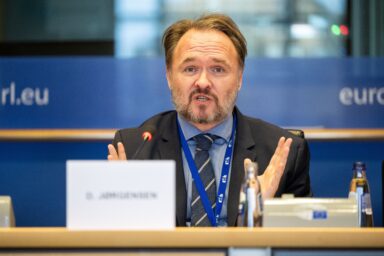The European Commission has proposed making it easier to flood the nascent emissions market with allowances if prices spike. Brussels thus responds to massive opposition to its flagship green policy the second iteration of the Emissions Trading System (and also delays its launch by a year). The moves mean that market stability and affordability have taken priority over rapid decarbonisation through price pressure.
The European Commission proposed tweaks to the Market Stability Reserve (MSR) for ETS2 on 27 November, the new emissions trading system targeting buildings and road transport. These changes aim to ensure a smoother launch of ETS2 by managing the supply of allowances and preventing sharp price spikes. They come after pressure from member states and MEPs to avoid disruption when the system kicks off.
“Today, we are delivering on the commitments we announced in October,“ Climate Commissioner Wopke Hoekstra said in a statement. Ever the diplomat, he sold the walk-back (which the Commission did not even bother to publish on its main news communication site) as a victory. “These measures further strengthen stability and affordability within ETS2 and set us on a more predictable path toward a low-carbon future,“ Mr Hoekstra said.
Short-term relief
The European Commission’s latest adjustments to ETS2 represent a retreat from the most aggressive forms of green policy enforcement, at least in the short term. The changes involve stronger intervention if prices rise above €45 per tonne, potentially doubling the number of allowances released to cool the market. The reserve’s capacity to hold and release allowances will also extend beyond 2030, making more allowances available to stabilise prices over the long term.
“We are setting the right conditions to keep prices in check and intervene swiftly if they go too high,” Commissioner Hoekstra said. The changes are designed to prevent sharp price increases in the carbon market for buildings and road transport, which had been a major concern for governments and businesses worried about economic disruption.
You might be interested
Additionally, the Commission proposes an earlier start to auctions with revenues flowing from 2027, and is working with the European Investment Bank on a frontloading facility to advance funds for investments. These measures seek to soften ETS2’s initial impact and support early carbon reduction efforts.
A softer landing for ETS2
The MSR amendments do not rewrite ETS2’s environmental goals but introduce mechanisms to temper market shocks. The “top-up” allowing up to 80 million allowances to be injected annually surpasses the expected annual emissions reduction of 60 million tonnes — a signal the Commission wants to rein in prices rather than let them run wild. Extending allowance validity also shows a shift towards greater supply-side flexibility over a longer horizon.
These measures further strengthen stability and affordability within ETS2 and set us on a more predictable path toward a low-carbon future. — Wopke Hoekstra, EU Climate Commissioner
This suggests the Commission is thus dialing back on its most ambitious price-driven enforcement measures, favouring a more gradual price discovery and avoiding sudden market volatility. The changes align with requests from governments facing political and economic realities in implementing ETS2.
The Commission still considers ETS2 crucial to hitting the EU’s 2030 climate target but appears more pragmatic about pacing the transition. It is using auction timing and financial instruments to bolster investments while cushioning the system’s initial impact on citizens and businesses.
Ongoing adjustments
ETS2 aims to reduce emissions in a technology-neutral way that maintains competitiveness. This update indicates the Commission is keen to avoid the turmoil that a too-rapid rollout might cause. It offers a blend of ambition and caution, seeking a steady path to the EU’s long-term goal of climate neutrality by 2050.
The Commission is also delaying the full launch of ETS2 by a year, to 2028, which further softens the initial impact. In effect, the Commission is responding to political and economic realities by watering down the most radical aspects of ETS2. The system will still push for emission reductions, but it will do so in a more gradual and less disruptive way.
This approach reflects a broader trend in EU climate policy. It entails balancing ambition with pragmatism, and the recognition that public and political support for green reforms depends on their perceived fairness and economic impact.










